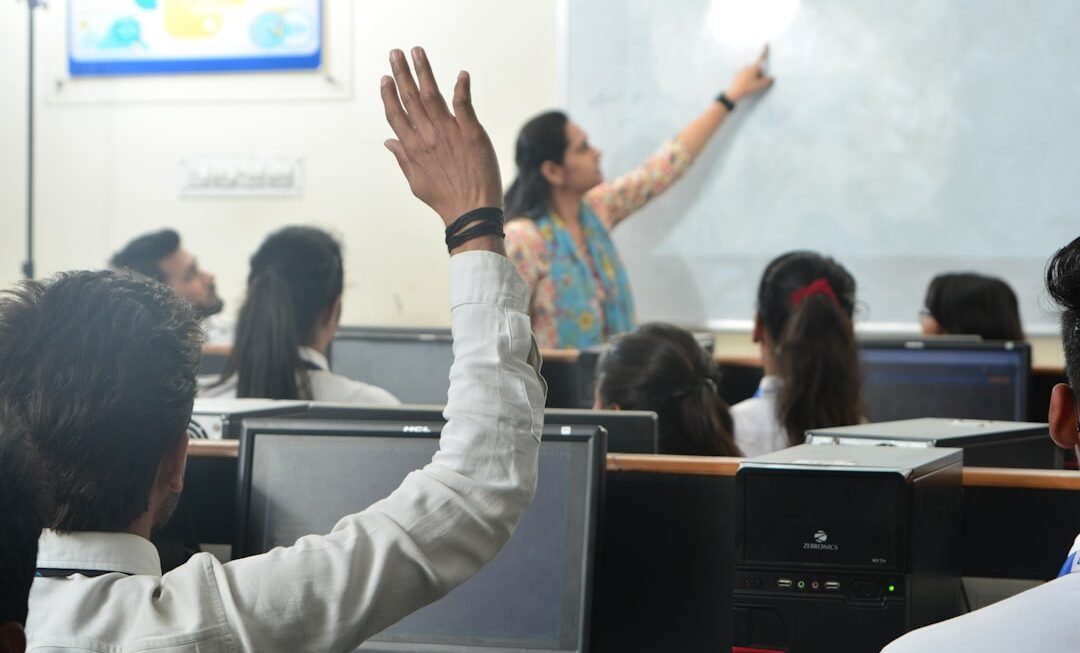In the rapidly evolving landscape of education, the shift towards virtual teaching has necessitated innovative approaches to enhance learning outcomes. Real-time analytics has emerged as a pivotal tool in this transformation, providing educators with immediate insights into student performance and engagement. The ability to analyze data as it is generated allows teachers to make informed decisions that can significantly impact the learning experience.
By harnessing real-time analytics, educators can create a more responsive and adaptive learning environment that meets the diverse needs of students. Moreover, the importance of real-time analytics extends beyond mere data collection; it encompasses the ability to interpret and act upon that data effectively.
For instance, educators can track attendance, participation rates, and assignment submissions in real time, enabling them to identify trends and patterns that may indicate a student’s level of engagement or understanding. This proactive approach allows for timely interventions, ensuring that no student falls behind. In an era where educational equity is paramount, real-time analytics serves as a critical mechanism for fostering inclusivity and supporting all learners in their educational journeys.
Key Takeaways
- Real-time analytics is crucial for virtual teaching as it provides immediate insights into student engagement and performance.
- Understanding real-time analytics and its application in virtual teaching is essential for educators to make data-driven decisions.
- Real-time analytics can enhance student engagement in virtual learning environments by providing personalized feedback and interventions.
- Using real-time analytics helps identify and address student learning gaps, allowing for targeted support and intervention.
- Leveraging real-time analytics enables personalized learning experiences for students, catering to their individual needs and learning styles.
Understanding Real-Time Analytics and its Application in Virtual Teaching
Data Sources
These analytics can be derived from learning management systems (LMS), online assessments, discussion forums, and even social media interactions related to educational content.
Insights and Feedback
The application of real-time analytics in virtual teaching allows educators to gain a comprehensive understanding of how students are engaging with the material and each other. For example, an LMS might provide insights into how long students spend on specific assignments or modules, which can indicate their level of interest or comprehension. Additionally, real-time feedback mechanisms, such as quizzes during live sessions, can help educators gauge student understanding on the spot.
Enhancing the Learning Experience
This immediate feedback loop not only informs instructional strategies but also empowers students to take ownership of their learning by providing them with insights into their own progress. As such, real-time analytics becomes an integral part of the educational process, facilitating a more dynamic and interactive learning environment.
How Real-Time Analytics Can Enhance Student Engagement in Virtual Learning Environments
Student engagement is a critical factor in the success of virtual learning environments. Real-time analytics plays a vital role in enhancing this engagement by providing educators with actionable insights into student behavior and preferences. For instance, by analyzing participation rates in discussions or collaborative projects, teachers can identify which students are actively engaged and which may require additional support or encouragement.
This data-driven approach allows for targeted interventions that can rekindle interest and motivation among students who may be struggling to connect with the material. Furthermore, real-time analytics can facilitate personalized learning experiences that cater to individual student needs. By tracking engagement metrics such as time spent on tasks or interaction frequency with peers and instructors, educators can tailor their teaching strategies to better align with student interests and learning styles.
For example, if analytics reveal that a particular group of students is consistently disengaged during lectures but thrives in group discussions, educators can adjust their instructional methods accordingly. This adaptability not only fosters a more engaging learning environment but also promotes a sense of agency among students, encouraging them to take an active role in their education.
Using Real-Time Analytics to Identify and Address Student Learning Gaps
One of the most significant advantages of real-time analytics in virtual teaching is its ability to identify learning gaps among students promptly. Traditional assessment methods often provide feedback after a significant delay, making it challenging for educators to address issues as they arise. In contrast, real-time analytics enables teachers to monitor student performance continuously, allowing them to pinpoint specific areas where students may be struggling.
For instance, if a teacher notices that a significant number of students are performing poorly on a particular topic or assignment, they can quickly implement targeted interventions to address these gaps. Moreover, real-time analytics can help educators differentiate instruction based on individual student needs. By analyzing data on assessment scores, participation levels, and engagement metrics, teachers can group students according to their proficiency levels and tailor their teaching strategies accordingly.
For example, students who demonstrate mastery of a concept can be challenged with advanced materials, while those who are struggling can receive additional support through targeted resources or one-on-one tutoring sessions. This proactive approach not only helps close learning gaps but also fosters a more inclusive classroom environment where all students have the opportunity to succeed.
Leveraging Real-Time Analytics to Provide Personalized Learning Experiences for Students
Personalized learning has gained traction as an effective educational approach that recognizes the unique needs and preferences of each student. Real-time analytics serves as a powerful tool in this endeavor by enabling educators to customize learning experiences based on individual performance data. By continuously monitoring student interactions with course materials and assessing their understanding through quizzes and assignments, teachers can gain valuable insights into each student’s strengths and weaknesses.
For instance, if analytics reveal that a student excels in visual learning but struggles with written assignments, educators can provide tailored resources such as video tutorials or interactive simulations that align with the student’s preferred learning style. Additionally, real-time feedback mechanisms allow students to receive immediate insights into their performance, empowering them to take charge of their learning journey. This level of personalization not only enhances student engagement but also fosters a deeper understanding of the material as learners are encouraged to explore topics at their own pace.
The Role of Real-Time Analytics in Monitoring Student Progress and Performance
Monitoring student progress is essential for ensuring that learners stay on track and achieve their academic goals. Real-time analytics provides educators with the tools necessary to track performance metrics continuously and make data-driven decisions regarding instructional strategies. By analyzing trends in student performance over time, teachers can identify patterns that may indicate potential challenges or areas for improvement.
For example, if a teacher observes a decline in performance across multiple assessments for a particular student or group of students, they can investigate further to determine the underlying causes. This might involve reviewing engagement levels during virtual classes or analyzing participation in collaborative activities. Armed with this information, educators can implement timely interventions—such as additional resources or modified instructional approaches—to support struggling learners before they fall too far behind.
The ability to monitor progress in real time not only enhances accountability but also fosters a culture of continuous improvement within the virtual classroom.
Implementing Real-Time Analytics to Improve Teacher Effectiveness in Virtual Teaching
The effectiveness of virtual teaching hinges not only on student engagement but also on the ability of educators to adapt their instructional practices based on data-driven insights. Real-time analytics provides teachers with valuable feedback regarding their teaching methods and overall effectiveness in facilitating student learning. By analyzing data related to student performance and engagement levels, educators can identify which strategies resonate most with their students and which may require adjustment.
For instance, if analytics indicate that students consistently perform better on assessments following interactive group activities compared to traditional lectures, teachers can prioritize collaborative learning experiences in their lesson plans. Additionally, real-time feedback from students regarding their understanding of concepts can inform instructional adjustments on the fly. This iterative process allows educators to refine their teaching practices continuously and create a more effective virtual learning environment that meets the diverse needs of all learners.
Overcoming Challenges and Limitations in Utilizing Real-Time Analytics in Virtual Teaching
While the benefits of real-time analytics in virtual teaching are substantial, there are also challenges and limitations that educators must navigate. One significant hurdle is the potential for data overload; with vast amounts of information generated from various sources, it can be overwhelming for teachers to sift through and extract meaningful insights. To address this challenge, educators must develop strategies for prioritizing key metrics that align with their instructional goals and focus on actionable data rather than getting lost in the minutiae.
Another challenge lies in ensuring data privacy and security when utilizing real-time analytics tools. Educators must be vigilant about protecting sensitive student information while still leveraging data to enhance learning outcomes.
By addressing these challenges head-on, educators can maximize the potential of real-time analytics while maintaining a safe and supportive virtual learning environment.
Best Practices for Integrating Real-Time Analytics into Virtual Teaching Platforms
To effectively integrate real-time analytics into virtual teaching platforms, educators should adopt several best practices that enhance both data utilization and instructional effectiveness. First and foremost, it is essential to select appropriate tools that align with educational objectives and provide user-friendly interfaces for both teachers and students. Platforms that offer intuitive dashboards for tracking performance metrics can streamline the process of data analysis.
Additionally, professional development opportunities focused on data literacy can empower educators to interpret analytics meaningfully and apply insights effectively in their teaching practices. Collaborating with colleagues to share best practices and strategies for utilizing real-time analytics can also foster a culture of continuous improvement within educational institutions. Finally, involving students in the process by providing them access to their performance data encourages self-reflection and accountability in their learning journeys.
The Future of Real-Time Analytics in Virtual Teaching: Trends and Innovations
As technology continues to advance at an unprecedented pace, the future of real-time analytics in virtual teaching holds exciting possibilities for enhancing educational experiences. One emerging trend is the integration of artificial intelligence (AI) into analytics platforms, enabling more sophisticated data analysis and predictive modeling capabilities. AI-driven tools can analyze vast datasets quickly and identify patterns that may not be immediately apparent to human observers.
Additionally, advancements in machine learning algorithms will allow for even more personalized learning experiences by adapting content delivery based on individual student needs in real time. As these technologies evolve, educators will have access to increasingly refined insights that can inform instructional practices and improve student outcomes significantly. Furthermore, the growing emphasis on social-emotional learning (SEL) will likely lead to the development of analytics tools that assess not only academic performance but also emotional well-being and engagement levels among students.
Case Studies and Success Stories: How Real-Time Analytics has Transformed Virtual Teaching Practices
Numerous case studies illustrate how real-time analytics has transformed virtual teaching practices across various educational settings. For instance, a prominent university implemented an LMS equipped with real-time analytics capabilities that allowed instructors to monitor student engagement during online courses actively. As a result, faculty members were able to identify disengaged students early on and implement targeted interventions such as personalized outreach or additional resources tailored to individual needs.
In another example, a K-12 school district adopted real-time analytics tools to track student progress across multiple subjects during remote learning periods. By analyzing engagement metrics alongside assessment scores, teachers were able to adjust their instructional strategies dynamically based on student performance trends. This proactive approach led to improved academic outcomes and increased overall satisfaction among both students and parents.
These success stories underscore the transformative potential of real-time analytics in virtual teaching environments. By leveraging data-driven insights effectively, educators can create more engaging, personalized, and responsive learning experiences that ultimately lead to better educational outcomes for all students.












